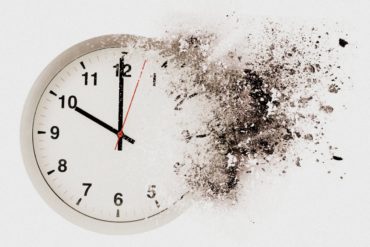Have you ever had the experience of looking back on your week with the sinking feeling that you didn’t get as much done as you’d hoped?
When building a successful career or a business of your own, your time is perhaps your most valuable asset — and your income is a direct result of how you spend your time.
You cannot buy any more time than you’re given, and the clock is always ticking. A few years ago, I discovered a simple system that allowed me to nearly triple my productivity, and below I’ll share some very practical ideas you can apply right away to increase your effectiveness without working any harder than you do now.

Keep a detailed time log.
The first step to better managing your time is to find out how you’re currently spending your time. Keeping a time log is a very effective way to do this, and after trying it for just one day, you’ll immediately gain tremendous insight into where your time is actually going.
The very act of measuring is often enough to raise your unconscious habits into your consciousness, where you then have a chance to scrutinize and change them.
Here’s how to keep a time log. Throughout your day record the time whenever you start or stop any activity. Consider using a stopwatch to just record time intervals for each activity. You can do this during only your working time or throughout your entire day. At the end of the day, sort all the time chunks into general categories, and find out what percentage of your time is being spent on each type of activity.
If you want to be thorough, do this for a week, and calculate the percentage of your total time that you spent on each type of activity. Be as detailed as possible. Note how much time you spend on email, reading newsgroups, web surfing, phone calls, eating, going to the bathroom, etc. If you get up out of your chair, it probably means you need to make an entry in your time log. I typically end up with 50-100 log entries per day.
You may be surprised to discover you’re spending only a small fraction of your working time doing what you’d consider to be actual work. Studies have shown that the average office worker does only 1.5 hours of actual work per day. The rest of the time is spent socializing, taking coffee breaks, eating, engaging in non-business communication, shuffling papers, and doing lots of other non-work tasks. The average full-time office worker doesn’t even start doing real work until 11:00am, and begins to wind down around 3:30pm.
1) Analyze your results.
The first time I kept a time log, I only finished 15 hours worth of real work in a week where I spent about 60 hours in my office. Even though I was technically about twice as productive as the average office worker, I was still disturbed by the results. Where did those other 45 hours go?
My time log laid it all out for me, showing me all the time drains I wasn’t consciously aware of — checking email too often, excessive perfectionism doing tasks that didn’t need to be done, over-reading the news, taking too much time for meals, succumbing to preventable interruptions, etc.
2) Calculate your personal efficiency ratio.
When I realized that I spent 60 hours at the office but only completed 15 hours of actual work within that time, I started asking myself some interesting questions.
My income and my sense of accomplishment depended only on those 15 hours, not on the total amount of time I spent at the office. So I decided to begin recording my daily efficiency ratio as the amount of time I spent on actual work divided by the total amount of time I spent in my office. While it certainly bothered me that I was only working 25% of the time initially, I also realized it would be extremely foolish to simply work longer hours.
Efficiency Ratio = (Time Doing “Real Work”) / (Time Spent “At Work”)
3) Cut back on total hours to force an increase in efficiency.
If you’ve ever tried to discipline yourself to do something you weren’t really motivated to do, you most likely failed. That was naturally the result I experienced when I tried to discipline myself to work harder. In fact, trying harder actually de-motivated me and drove my efficiency ratio even lower.
So I reluctantly decided to try the opposite approach. The next day I would only allow myself to put in five hours total at the office, and the rest of the day I wouldn’t allow myself to work at all.
Well, an interesting thing happened, as I’m sure you can imagine. My brain must have gotten the idea that working time was a scarce commodity because I worked almost the entire five hours straight and got an efficiency ratio of over 90%. I continued this experiment for the rest of the week and ended up getting about 25 hours of work done with only 30 hours total spent in my office, for an efficiency ratio of over 80%. So I was able to reduce my weekly working time by 30 hours while also getting 10 more hours of real work done.
If your time log shows your efficiency ratio to be on the low side, try severely limiting your total amount of working time for a day, and see what happens. Once your brain realizes that working time is scarce, you suddenly become a lot more efficient because you have to be. When you have tight time constraints, you will usually find a way to get your work done. But when you have all the time in the world, it’s too easy to be inefficient.
4) Gradually increase total hours while maintaining peak efficiency.
Over a period of a few weeks, I was able to keep my efficiency ratio above 80% while gradually increasing my total weekly office time.
I’ve been able to maintain this for many years now, and I commonly get about 40 hours of real work done every week, while only spending about 45 total hours in my office. I’ve learned that this is ideal for me. If I try to put in more time at the office, then my productivity drops off rapidly.
The interesting thing is that the system that allowed me to optimize my effectiveness at work also created a tremendous amount of balance in all other areas of my life. Even though I was able to use this approach to triple my business productivity, I still gained plenty of time to pursue personal interests.
Time logging is the intelligent choice to ensure optimal productivity without increasing your hours. But time logging need only be done periodically to provide these benefits. I do it for one week every 3-6 months, and over the years it has made a huge difference for me, always providing me with new distinctions. If I go too many months without time logging, my productivity gradually drops as I fall back into unconscious time-wasting habits. You’ll probably find as I do that your gut feelings about your productivity are closely related to how much real work you actually get done.
When you feel your productivity is lower than you’d like, raise your awareness via time logging, measure your efficiency ratio, and then optimize your efficiency to boost your productivity back up where it belongs. Time logging is a high leverage activity that takes very little time and effort to implement, but the long-term payoff is tremendous.







